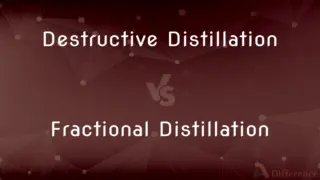Cow Digestive System vs. Human Digestive System — What's the Difference?
By Tayyaba Rehman — Published on January 8, 2024
Cows have a four-chambered stomach for digesting tough plant matter; humans have a single-chambered stomach, suited for a varied diet.

Difference Between Cow Digestive System and Human Digestive System
Table of Contents
ADVERTISEMENT
Key Differences
The Cow Digestive System is complex, featuring a four-chambered stomach including the rumen, reticulum, omasum, and abomasum. This system efficiently breaks down tough plant fibers like cellulose.
The Human Digestive System consists of a single-chambered stomach, small and large intestines, and accessory organs like the liver and pancreas. It is adapted to a diverse diet but can't break down cellulose effectively.
Cows, being ruminants, regurgitate partially digested food (cud) and chew it again. This process, called rumination, further breaks down the plant material.
Humans, on the other hand, have a one-step digestive process where food doesn't return to the mouth after being swallowed. Human digestion relies heavily on stomach acids and enzymes.
The Cow Digestive System harbors a vast community of microbes in the rumen, aiding in the breakdown of cellulose. This microbial fermentation produces volatile fatty acids, a primary energy source for cows.
ADVERTISEMENT
Human digestion, while also involving microbial action in the large intestine, doesn't rely on microbes for the primary breakdown of food. Nutrient absorption mainly occurs in the small intestine.
Comparison Chart
Stomach Chambers
Four
One
Digestion of Cellulose
Efficient
Inefficient
Regurgitation Process
Common (Cud chewing)
Absent
Primary Digestion Site
Rumen
Stomach
Microbial Role
Essential in the rumen
Secondary in the large intestine
Compare with Definitions
Cow Digestive System
The Cow Digestive System features rumination for further breakdown of food.
Observing a cow chewing cud demonstrates the rumination aspect of the Cow Digestive System.
Human Digestive System
The Human Digestive System involves both mechanical and chemical digestion.
Chewing is part of the mechanical aspect of the Human Digestive System.
Cow Digestive System
The Cow Digestive System is adapted to extract nutrients from tough plant fibers.
Thanks to their specialized digestive system, cows can convert grass into energy.
Human Digestive System
The Human Digestive System's small intestine is crucial for nutrient absorption.
Most nutrient absorption occurs in the small intestine of the Human Digestive System.
Cow Digestive System
The Cow Digestive System includes the reticulum, omasum, and abomasum.
Each chamber of the Cow Digestive System has a specific role in digestion.
Human Digestive System
The Human Digestive System includes organs like the stomach and intestines.
The stomach plays a key role in the Human Digestive System by breaking down food.
Cow Digestive System
The rumen, a part of the Cow Digestive System, hosts microbes for digestion.
The rumen's microbial population is crucial to the Cow Digestive System's functionality.
Human Digestive System
The Human Digestive System processes food from ingestion to excretion.
The Human Digestive System is essential for nutrient absorption and waste elimination.
Cow Digestive System
The Cow Digestive System includes a four-chambered stomach for processing plant material.
The efficiency of the Cow Digestive System allows cows to thrive on grass.
Human Digestive System
The Human Digestive System is not suited for digesting cellulose.
Unlike ruminants, the Human Digestive System can't efficiently break down fibrous plants.
Common Curiosities
Can cows digest cellulose efficiently?
Yes, the Cow Digestive System is specialized to efficiently digest cellulose.
How does rumination work in the Cow Digestive System?
In rumination, cows regurgitate partially digested food to chew it again for further breakdown.
Is the Cow Digestive System more complex than the Human Digestive System?
Yes, the Cow Digestive System is more complex, particularly due to its multi-chambered stomach and rumination process.
Where does most nutrient absorption occur in humans?
Most nutrient absorption in the Human Digestive System occurs in the small intestine.
How many stomach chambers does the Human Digestive System have?
The Human Digestive System has a single-chambered stomach.
Why can't humans digest grass effectively?
The Human Digestive System lacks the necessary mechanisms to break down the cellulose in grass.
Do humans chew cud like cows?
No, cud chewing is specific to ruminants like cows and doesn't occur in the Human Digestive System.
What is the role of the stomach in the Human Digestive System?
The stomach in the Human Digestive System breaks down food using acids and enzymes.
What are the main components of the Cow Digestive System?
The Cow Digestive System includes a four-chambered stomach, intestines, and other associated organs.
Can the Cow Digestive System process meat?
No, the Cow Digestive System is adapted for plant material, not for digesting meat.
What is the primary energy source for cows?
Volatile fatty acids, produced through microbial fermentation in the rumen, are a primary energy source in the Cow Digestive System.
What role do microbes play in the Human Digestive System?
Microbes in the Human Digestive System, especially in the large intestine, aid in digestion and produce certain vitamins.
Do humans have a rumen?
No, the rumen is specific to ruminants like cows and is absent in the Human Digestive System.
Are cows' intestines longer than humans'?
Yes, cows have longer intestines compared to humans, suitable for digesting fibrous plant material.
How does food move through the Human Digestive System?
Food moves through the Human Digestive System via peristalsis, a series of muscle contractions along the digestive tract.
Share Your Discovery

Previous Comparison
Destructive Distillation vs. Fractional Distillation
Next Comparison
Brother Printer vs. HP PrinterAuthor Spotlight
Written by
Tayyaba RehmanTayyaba Rehman is a distinguished writer, currently serving as a primary contributor to askdifference.com. As a researcher in semantics and etymology, Tayyaba's passion for the complexity of languages and their distinctions has found a perfect home on the platform. Tayyaba delves into the intricacies of language, distinguishing between commonly confused words and phrases, thereby providing clarity for readers worldwide.














































